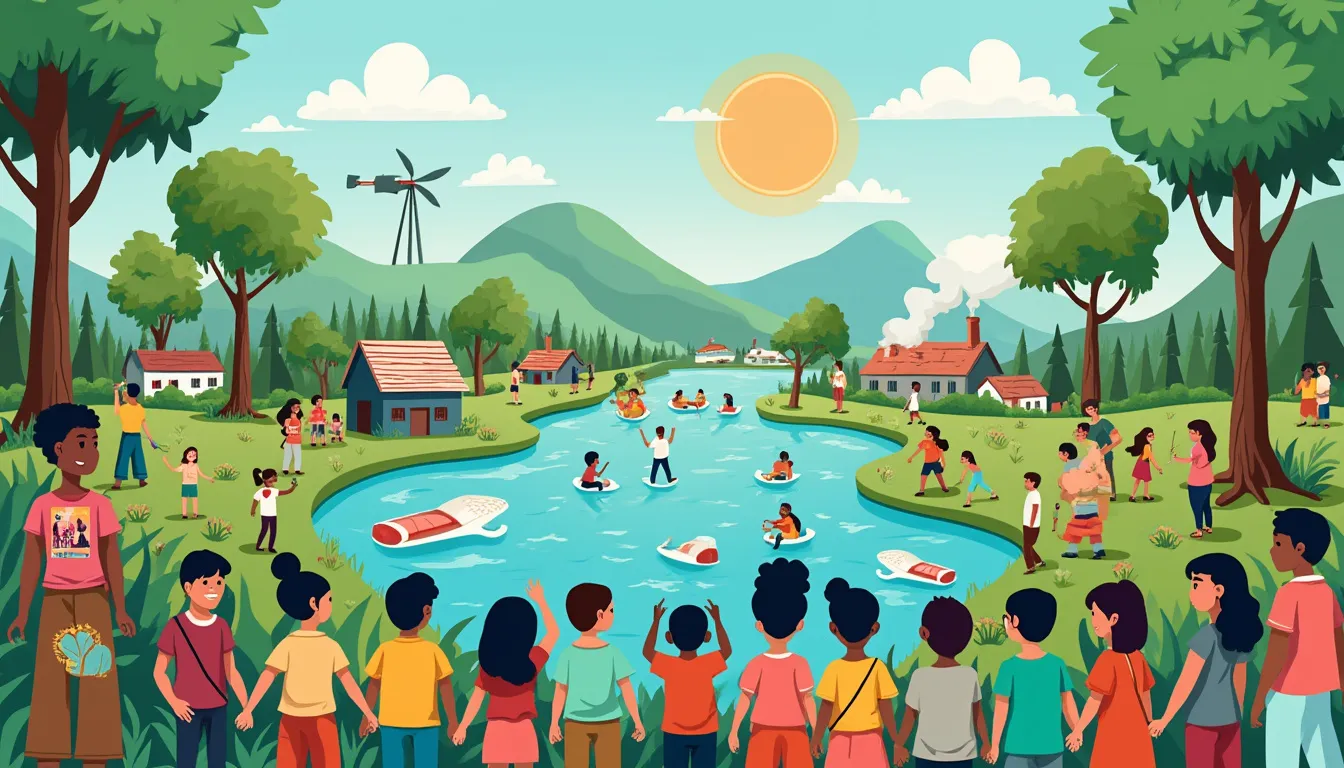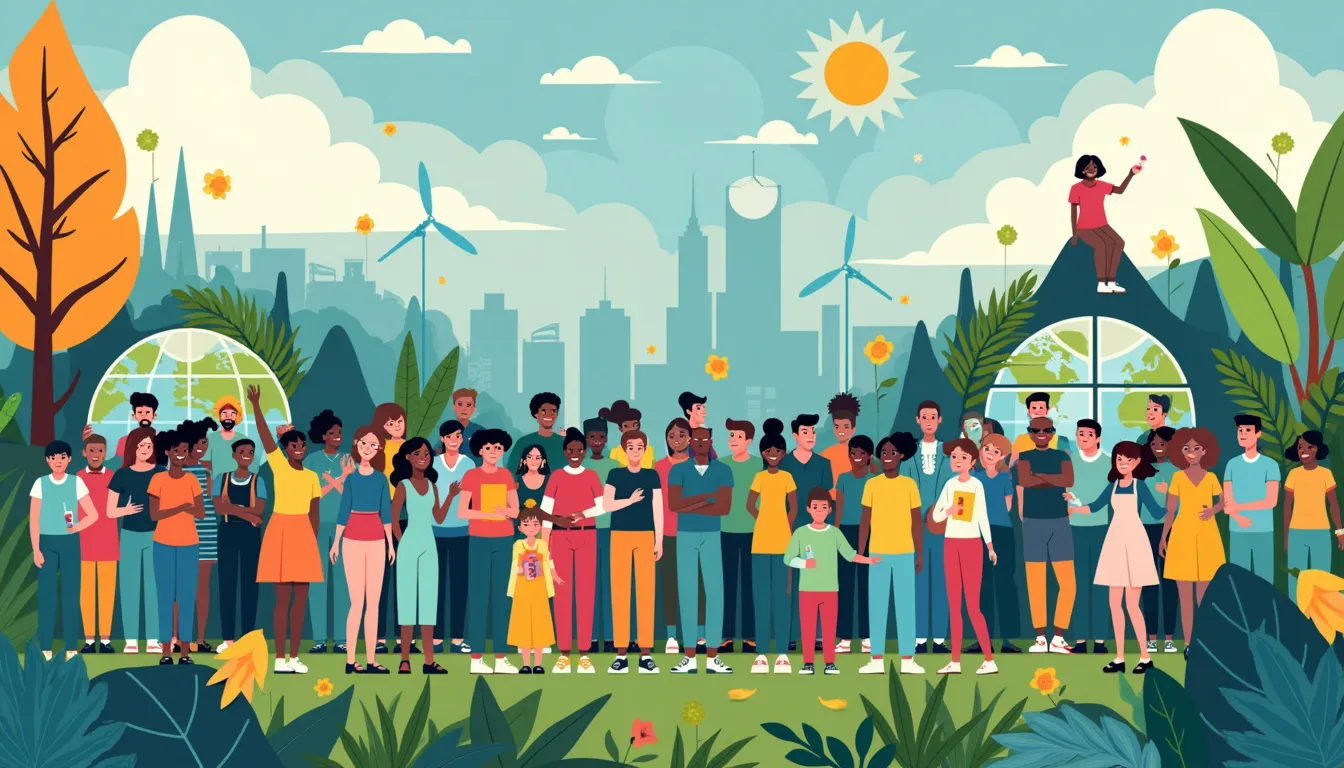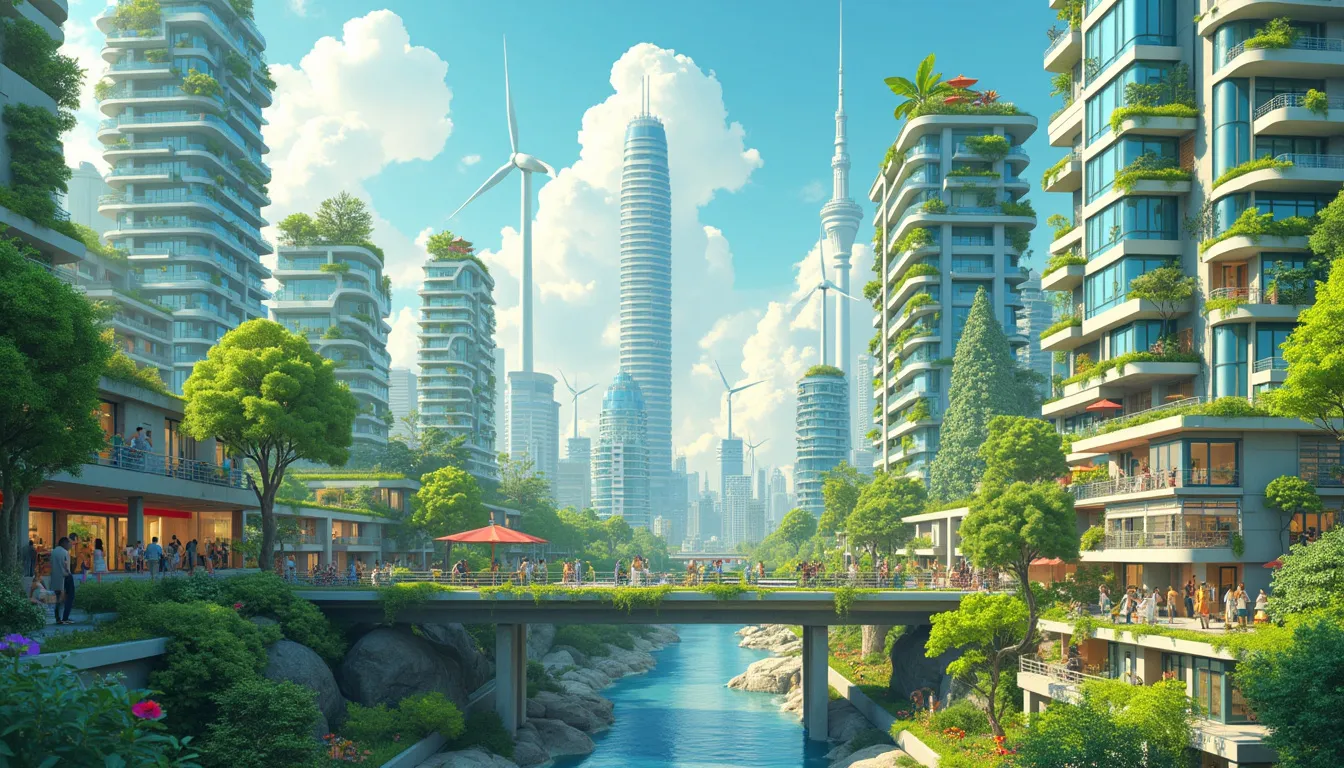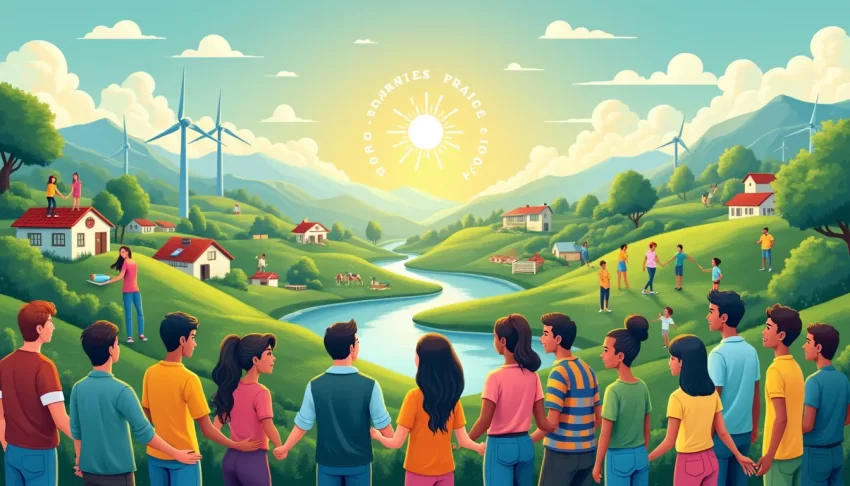Imagine a world where poverty is eradicated, inequality is history, and the environment is preserved for future generations. This vision isn’t just a utopian dream but a structured plan embodied in the Sustainable Development Goals (SDGs). Launched by the United Nations in 2015, the SDGs consist of 17 interconnected goals aimed at addressing global challenges and fostering a more prosperous and equitable world by 2030. From eliminating hunger and ensuring quality education to promoting clean energy and bolstering economic growth, these goals provide a roadmap for countries, organizations, and individuals to contribute to sustainable development.
Understanding the importance of the Sustainable Development Goals is crucial, as they serve as a comprehensive framework for global development efforts. They recognize that ending poverty and other deprivations must go hand-in-hand with strategies that improve health and education, reduce inequality, and spur economic growth—all while tackling climate change and working to preserve our oceans and forests. These goals are not only ambitious but also essential in creating a world that is fair, just, and capable of supporting future generations.
However, achieving the sustainable development goals is no small feat. It requires collaboration, commitment, and creativity from all sectors of society. As we delve into the major challenges, such as economic barriers, social inequities, and environmental degradation, we’ll explore how different regions and countries are striving to overcome these obstacles. We’ll examine innovative solutions and best practices that are making a significant impact, showcasing that progress, though slow at times, is attainable.
To inspire and engage further action, we’ll highlight successful projects and initiatives that are leading the way in the implementation of sustainable development goals. From grassroots movements to global partnerships, these examples underscore the power of collective effort and visionary thinking. Additionally, we’ll look ahead to the future of sustainable development goals, discussing forecasts for 2030 and beyond, and emphasizing the critical need for continuous monitoring, adaptation, and global cooperation.
Ultimately, this journey toward achieving the Sustainable Development Goals calls for each of us to play a part. Whether as individuals, business owners, or policy-makers, the choices we make today can significantly influence the world of tomorrow. By adopting sustainable practices in our daily lives and supporting policies that foster sustainability, we contribute to a shared path that leads to a better, more sustainable future for all.
Introduction to Sustainable Development Goals (SDGs)
The Sustainable Development Goals (SDGs) are a collection of 17 interlinked global goals designed to be a blueprint to achieve a better and more sustainable future for all. Set in 2015 by the United Nations General Assembly, these goals are intended to be achieved by the year 2030. They address the global challenges we face, including those related to poverty, inequality, climate change, environmental degradation, peace, and justice.
The importance of the Sustainable Development Goals cannot be overstated. They offer a galvanizing vision of a world where everyone has access to clean water, education, and economic opportunity, and where environmental health is preserved. In an era marked by rapid technological advances and increasing globalization, the SDGs serve as a comprehensive framework to guide nations, businesses, and individuals toward sustainable development.
Delving into the nuts and bolts, each of the 17 goals comes with a set of targets designed to address specific issues. For instance, Goal 1 focuses on ending poverty in all its forms everywhere, while Goal 13 aims to take urgent action to combat climate change and its impacts. These targets serve as measurable benchmarks for assessing progress and ensuring accountability.
Take for example, Goal 3, which aims to ensure healthy lives and promote well-being for all at all ages. Sub-targets include reducing the global maternal mortality ratio to less than 70 per 100,000 live births and ending the epidemics of AIDS, tuberculosis, malaria, and neglected tropical diseases by 2030. Such specific, actionable targets offer a roadmap for both policy-makers and practitioners.
The journey toward achieving these sustainable development goals has already started yielding notable successes. The global extreme poverty rate fell from 10% in 2015 to 9.2% in 2017, and more renewable energy projects are being implemented worldwide than ever before. Such progress illustrates the capacity for change when aligned with the SDGs framework.
However, significant work remains. As we continue to push forward, the commitment of all sectors of society becomes imperative. Governments, private sector companies, non-governmental organizations, and individuals all play vital roles in achieving sustainable development goals. Businesses, for example, can adopt sustainable practices by reducing waste and emissions, while individuals can contribute by making environmentally responsible choices and advocating for policy changes.
In contemporary global development, the SDGs serve as a clarion call to collectively envision and work towards a balanced, equitable, and sustainable future. With just seven years left until 2030, the importance of widespread and coordinated action is becoming increasingly urgent. We are at a crossroads where our choices today will significantly impact future generations.
Indeed, the SDGs are essential for fostering a more sustainable and interconnected world. As UN Secretary-General António Guterres said, The 2030 Agenda for Sustainable Development is our shared roadmap to create a better world for people and our planet. It’s an urgent call to shift the world onto a more sustainable path.
By understanding the Sustainable Development Goals, acknowledging their importance, and mobilizing efforts across diverse spheres of influence, we set the stage for meaningful progress. The road is long and fraught with challenges, but the potential rewards—a safer, healthier, and more equitable world—make the journey more than worthwhile.

Key Challenges in Achieving the Sustainable Development Goals
The journey toward achieving sustainable development goals is fraught with numerous challenges that span economic, social, and environmental spheres. These obstacles are multifaceted and often intertwined, requiring a comprehensive approach to address them effectively.
Economic Challenges
One of the most significant economic challenges in achieving sustainable development goals is poverty. Remaining entrenched poverty levels hinder access to education, healthcare, and other essential services, perpetuating a cycle of deprivation. For instance, in sub-Saharan Africa, the poverty rate stands at 41%, making it difficult for countries in the region to invest in sustainable development initiatives.
Additionally, the lack of infrastructure and financial resources prevents many countries from making the necessary investments in renewable energy, sustainable agriculture, and other areas critical to achieving the sustainable development goals. Emerging economies often grapple with massive debt burdens, limiting their ability to focus on long-term sustainability.
Social Challenges
Social inequalities are another major barriers to achieving sustainable development goals. Gender inequality, for example, restricts women’s access to education, healthcare, and economic opportunities. In many parts of the world, women and girls face systemic discrimination, which undermines their potential to contribute to sustainable development efforts. In rural India, initiatives aimed at fostering female education often face resistance due to deep-rooted cultural norms, showcasing the complexity of social challenges.
Moreover, social unrest and political instability can derail sustainable development efforts. Conflict zones see disastrous human and economic losses, pushing development off course. The Syrian conflict, for instance, has severely undermined progress on multiple SDGs, including those related to education, health, and poverty.
Environmental Challenges
The environmental challenges to achieving sustainable development goals are perhaps the most pressing. Climate change stands at the forefront, causing severe weather events, rising sea levels, and shifts in ecosystems that directly impact agriculture, water supply, and biodiversity. The frequency of natural disasters, such as hurricanes in the Caribbean and wildfires in Australia, illustrates the immediate need for robust environmental strategies.
Pollution is another significant concern. Air and water pollution in industrializing regions not only harm public health but also degrade natural ecosystems. Addressing pollution requires not only technological advancements but also stringent policy measures and international cooperation.
Case Studies of Countries Facing Difficulties
Examining specific countries provides deeper insights into the challenges of achieving sustainable development goals. One illustrative case is Haiti. Despite substantial international aid, Haiti remains one of the poorest countries in the world. Frequent natural disasters, such as the devastating 2010 earthquake, combined with political instability, have significantly hindered the country’s progress on the sustainable development goals.
Another example is Yemen, where ongoing conflict has led to one of the worst humanitarian crises globally. With millions facing famine and severe healthcare shortages, Yemen’s ability to achieve sustainable development goals related to health, education, and poverty is significantly compromised.
Possible Solutions to Overcome These Challenges
While the obstacles to achieving sustainable development goals are considerable, various solutions can help mitigate these challenges. Economic empowerment initiatives, such as microfinancing and vocational training, can provide the necessary tools for individuals in impoverished regions to improve their livelihoods. For example, Grameen Bank’s microfinance model has shown remarkable success in Bangladesh, lifting millions out of poverty.
Addressing social inequalities requires comprehensive strategies that promote inclusivity and equality. Education programs targeting girls and marginalized communities can create a more equitable society, thus contributing to sustainable development. The “Educate a Child” program in Pakistan, which aims to increase school enrollment rates among girls, is a prime example of how targeted interventions can yield substantial benefits.
Environmental challenges can be tackled through innovative technologies and international cooperation. Renewable energy projects, reforestation efforts, and sustainable agriculture practices are critical components. One success story is Costa Rica, where the government has invested heavily in renewable energy and reforestation, making the country a leader in sustainability.
Furthermore, global partnerships and cooperation are essential. The Paris Agreement is a testament to what can be achieved when countries unite to address environmental challenges. Such international frameworks provide a platform for sharing knowledge, resources, and best practices, fostering a collaborative approach to sustainable development.
Tackling the challenges in achieving sustainable development goals will require a concerted effort from all sectors of society. By addressing economic, social, and environmental obstacles through targeted interventions and global cooperation, we can move closer to a sustainable and equitable future.

Strategies for Successful Implementation of the Sustainable Development Goals
The journey towards the successful implementation of the Sustainable Development Goals (SDGs) involves a collective effort from governments, organizations, and individuals. Each stakeholder plays a critical role in shaping a sustainable future, and through innovative approaches and best practices, we can pave the way for significant progress. In this section, we will explore the roles of various entities, highlight some creative methods, and showcase successful examples that can serve as models for others.
Role of Governments, Organizations, and Individuals
Governments hold the primary responsibility for creating policies and frameworks that support the implementation of sustainable development goals. They can incentivize sustainable practices, enforce regulations to protect the environment, and allocate funds for projects that advance the SDGs. For instance, Costa Rica has set a remarkable example by implementing policies that promote renewable energy, resulting in approximately 98% of its electricity coming from renewable sources.
Organizations, both private and nonprofit, are equally significant. Businesses can adopt sustainable practices by reducing their carbon footprints, incorporating circular economy principles, and ensuring ethical supply chains. Nonprofits can fuel grassroots changes and bring community-driven initiatives to the forefront. For example, Unilever’s Sustainable Living Plan aims to halve the company’s environmental footprint by 2030 while enhancing social impact, demonstrating how corporate commitment can drive substantial progress.
Individuals, too, play a crucial role. Simple changes in daily habits, like reducing waste, conserving energy, and supporting sustainable products, can collectively make a massive impact. Education and awareness are vital, empowering people to make informed choices that align with the goals of sustainability.
Innovative Approaches and Best Practices
Innovation is the bedrock of progress in the implementation of sustainable development goals. One innovative approach is the integration of technology in sustainability efforts. Smart cities, for example, utilize data and technology to improve infrastructure, enhance resource efficiency, and reduce ecological footprints. Barcelona’s smart city initiative has implemented smart street lighting and waste management systems, drastically reducing energy consumption and operational costs.
Another innovative practice is the promotion of sustainable agriculture through permaculture and agroforestry. These methods not only increase productivity but also restore biodiversity and enhance soil health. The World Agroforestry Centre’s projects across Africa have helped millions of smallholder farmers adapt to climate change while improving their livelihoods.
Furthermore, public-private partnerships are proving to be highly effective in driving sustainable development. By combining the strengths of the public and private sectors, these collaborations can achieve goals that would be impossible for either sector alone. One notable example is the Global Alliance for Vaccines and Immunization (Gavi), which unites governments, manufacturers, and NGOs to improve immunization rates in low-income countries, directly contributing to SDG 3: Good Health and Well-Being.
Examples of Successful Projects and Initiatives
Let’s consider some successful projects that have made notable strides in implementing the sustainable development goals.
The Great Green Wall Initiative: This ambitious African-led movement aims to grow an 8,000 km natural wonder across the Sahel region, promoting sustainable land management and biodiversity. This initiative not only addresses desertification and climate change but also creates jobs and improves food security, contributing to multiple SDGs.
The Solar Cities Initiative in India: India’s Solar Cities program aims to reduce energy consumption by promoting the use of renewable energy. The city of Ahmedabad, as part of this initiative, has installed solar panels on rooftops, solar street lights, and solar water heaters, significantly lowering its carbon emissions and energy costs.
Plastic Bank: This social enterprise enables people to exchange plastic waste for valuable items like cooking fuel, school tuition, or cash. By incentivizing recycling and providing value to what is often seen as trash, Plastic Bank not only reduces ocean-bound plastic but also combats poverty, aligning with SDG 14: Life Below Water, and SDG 1: No Poverty.
The Living Building Challenge: An international sustainable building certification program that sets rigorous standards for green building design, construction, and operation. Buildings certified under this program must meet criteria like net-zero energy and water usage, positively impacting SDG 11: Sustainable Cities and Communities.
The successful implementation of sustainable development goals requires a multifaceted approach that includes innovative solutions and the collaboration of diverse stakeholders. By drawing inspiration from successful projects and adapting best practices, governments, organizations, and individuals can contribute to a sustainable future. Through concerted efforts, we can ensure that the SDGs are not merely aspirational but achievable milestones leading towards a thriving planet for all.

The Future Outlook: Ensuring Long-term Success of the Sustainable Development Goals
As we rapidly approach 2030, the milestone year set for achieving the Sustainable Development Goals (SDGs), it’s essential to reflect on both our progress and the road that lies ahead. The future of sustainable development goals hinges on continued effort, innovation, and cooperation at every level of society. Let’s explore what this future might look like, the importance of monitoring, and the collective responsibility required to sustain these efforts beyond 2030.
Predictions and Goals for 2030 and Beyond
By 2030, numerous SDGs target specific achievements, such as eradicating extreme poverty and hunger, ensuring quality education for all, and achieving gender equality. However, the future of sustainable development goals extends beyond ticking boxes. It’s about embedding these goals into the fabric of global development so that improvements are sustainable and resilient to future challenges.
One optimistic prediction is the rise of technology and innovation driving progress. For example, advancements in renewable energy could make sustainable power accessible to remote regions, addressing both SDG 7 (Affordable and Clean Energy) and SDG 13 (Climate Action). Similarly, the widespread adaptation of smart agriculture technologies might help meet SDG 2 (Zero Hunger) by optimizing resource use and boosting food production efficiency.
However, these advancements must be equitable. Focusing on inclusivity ensures that marginalized communities benefit from progress, aligning with SDG 10 (Reduced Inequalities). The future vision is one where development uplifts everyone, leaving no one behind.
Importance of Continuous Monitoring and Adaptation
Continuous monitoring and adaptation are crucial for sustaining the progress of the Sustainable Development Goals. The global landscape is dynamic, with evolving challenges such as climate change, economic fluctuations, and sociopolitical shifts. Effective monitoring allows stakeholders to track progress accurately and identify areas needing intervention.
For instance, the United Nations’ High-Level Political Forum on Sustainable Development provides a platform for member states to share progress, challenges, and lessons learned. Creating similar localized monitoring mechanisms can help communities stay aligned with their specific goals while contributing to the global agenda.
Adapting strategies based on data and feedback is equally important. For example, if a particular initiative aimed at improving educational outcomes (SDG 4) is not yielding expected results, analyzing the data might reveal the need for additional resources or changes in approach. Adaptive management ensures that efforts remain effective and relevant, addressing issues as they arise rather than after the fact.
Call to Action for Global Cooperation and Commitment
The future of sustainable development goals is dependent on unwavering global cooperation and commitment. Individual actions alone won’t suffice; a collective effort from governments, businesses, civil society, and individuals is vital. Collaborative frameworks, like the Paris Agreement for climate change (supporting SDG 13), exemplify how international cooperation can drive substantial progress.
At the business level, companies can contribute by integrating sustainability into their core strategies, aligning their operations with SDGs. For example, a company might reduce its carbon footprint by implementing energy-efficient practices and sourcing materials responsibly. Such actions not only contribute to SDGs but also enhance the company’s sustainability credentials and appeal to an increasingly eco-conscious consumer base.
Individuals, too, play a crucial role. Simple actions like reducing waste, conserving water, supporting fair trade products, and advocating for sustainable policies contribute to the broader agenda. Encouragingly, many communities worldwide are already embracing sustainable practices, demonstrating the powerful impact of grassroots movements.
Furthermore, educational institutions can foster a culture of sustainability by incorporating SDGs into their curricula, empowering the next generation with the knowledge and skills needed to drive sustainable development. Engaging younger generations ensures continuity and innovation, keeping the momentum alive beyond 2030.
In conclusion, the future of sustainable development goals lies in sustained, cooperative efforts and adaptive strategies. As we progress towards 2030 and beyond, the commitment to these goals must be unwavering. From leveraging technology and inclusive advancements to fostering continuous monitoring and global cooperation, every step taken today shapes a better, sustainable future.
In closing, the journey to achieving the Sustainable Development Goals (SDGs) is not just a lofty aspiration but a critical path we must tread for the sake of our planet and future generations. We’ve explored the essence of the SDGs, underlining their pivotal role in guiding global development towards equity, prosperity, and environmental stewardship. The challenges are myriad and complex, ranging from economic disparities to environmental degradation, all compounded by social inequities. Yet, through the stories of various nations grappling with these obstacles, we see beacons of hope and resilience. Solutions are indeed within reach, whether through innovative policymaking, cross-sector partnerships, or grassroots movements that fuel change from the ground up.
The implementation of the Sustainable Development Goals requires a concerted effort from every sector of society. Governments need to enact and enforce policies that promote sustainability, organizations must integrate sustainable practices into their operations, and individuals can contribute by making mindful choices in their daily lives. The successes we have witnessed—those pioneering projects and community-led initiatives—serve as inspiring examples of what is possible when determination meets ingenuity.
Looking ahead, the future of sustainable development goals is one that hinges on our collective will to adapt and persevere. As 2030 approaches, our focus must be on sustaining momentum, continuously monitoring progress, and being agile enough to address emerging challenges. This global endeavor demands unwavering commitment and cooperation, transcending borders and bridging divides. Let us remember that every action, no matter how small it may seem, contributes to a larger tapestry of global sustainability. By fostering a culture of sustainability in our personal lives and extending that ethos into the business realm, we can drive meaningful change and secure a thriving future for all. Together, we can achieve the Sustainable Development Goals and carve out a brighter, more sustainable world.
Support Us: Check out our recommended products on Amazon.

